Biology IGCSE (Paper 1 ONLY)
1/320
Earn XP
Description and Tags
Name | Mastery | Learn | Test | Matching | Spaced |
|---|
No study sessions yet.
321 Terms
Characteristics of living organisms
Movement
Respiration
Sensitivity
Control
Growth
Reproduction
Excretion
Nutrition
Characteristics of living organisms mnemonic
MRS C GREN
Movement
Organisms move towards water + food, move away from predators + poison
Even plants move a bit
Respiration
Release energy from food
Sensitivity
React to changes to environment
Control
Control internal conditions, including temp + water content
Growth
Grow and develop into adult form
Reproduction
Produce offspring for their species to survive
Excretion
Removal of waste products such as carbon dioxide + urine
Nutrition
Need nutrients to provide energy + raw materials for growth and repair
Nutrients include proteins, fats, carbohydrates
Eukaryotic
Cells contain nucleus surrounded by membrane and other organelles
Prokaryotic
No nucleus, mitochondria or chloroplasts
Plants
Eukarotic
Multicellular
Contain chloroplasts + carry out PSN
Cellulose cell wall
Store carbohydrates as sucrose or starch
e.g. Flowering plants: cereals (maize), herbaceous legumes (peas, beans)
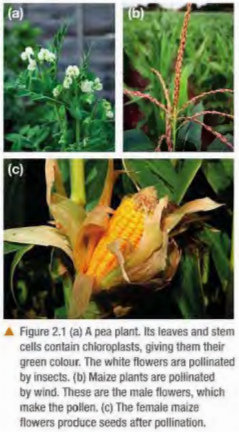
Animals
Eukaryotic
Multicellular
No chloroplasts so no PSN
No cell wall so cells can change shape (important for movement)
Most have some kind of nervous coordination, so can rapidly respond to changes in environment
Move around from one place to another
Store carbohydrate in cells as glycogen
e.g. Mammals (humans), insects (houseflies, mosquitoes)

Fungi
Eukaryotic
Some unicellular
Others have body called mycelium, made up of hyphae (thread-like structures), which contain lots of nuclei
Can’t do PSN
Cell wall made of chitin
Most feed by saprotrophic nutrition - secrete extracellular enzymes into area outside their body to dissolve food so they can absorb nutrients
Store carbohydrates as glycogen
e.g. Yeast (single-celled), Mucor (multicellular, has mycelium + hyphae)
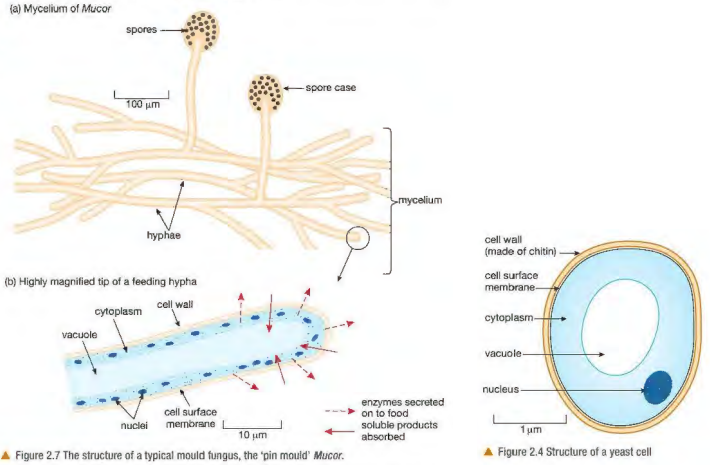
Protoctists
Eukaryotic
Most are single-celled
Some look like animal cells, protozoa
Others are more like plants - have chloroplasts so carry out PSN, e.g. algae
Most algae are unicellular, but some are multicellular e.g. seaweed
Some protoctists are agents of disease, e.g. Plasmodium, causing malaria
e.g. Chlorella (plant cell-like), Amoeba (animal cell-like, lives in pond water)

Bacteria
Prokaryotic
Unicellular
Cell wall, protecting bacterium + keeping shape of cell
Cell wall made of peptidoglycan (complex compound of sugars + proteins)
No nucleus so DNA is loose in cytoplasm
Some can swim using flagella
Most contain plasmids, small circular rings of DNA
Some can do PSN
Most feed off other organisms, living and dead
e.g. Lactobacillus bulgaricus (can be used to make milk go sour + turn into yoghurt, rod-shaped), Pneumococcus (spherical shape)
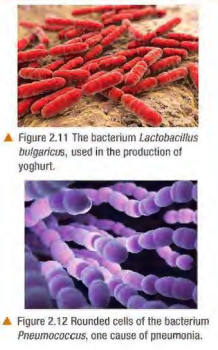
Viruses
Particles rather than cells, smaller than bacteria
Can only reproduce inside living cells - depends on another organism to grow + reproduce
Infect all types of organism
Many shapes + sizes
No cellular structure - have protein coat around genetic material (either DNA or RNA)
e.g. Influenza, HIV, Tobacco mosaic (makes plant leaves discoloured by stopping them from producing chloroplasts)
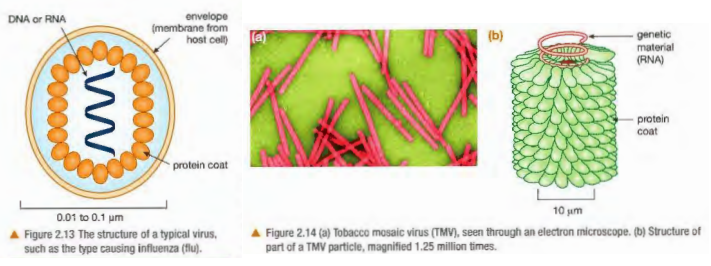
Pathogen
Disease-causing organisms, including some fungi, protoctists and bacteria
Viruses are also pathogens (although not living)
e.g.
Protoctist: Plasmodium, causes malaria
Bacterium: Pneumococcus, causes pneumonia
Viruses: Influenza, causes ‘flu’, HIV, causes AIDS, Tobacco mosaic virus, causes leaf discolouration in plants by preventing formation of chloroplasts
Organelle
compartment within a cell that has a specialised function
e.g. nucleus
Cell
basic structural unit of living organisms, can be eukaryotic or prokaryotic
e.g. root hair cell
Tissue
a collection of similar cells working together to perform a function
e.g. plants have xylem + phloem tissue
Organ
group of diff. tissues working together to perform a function
e.g. lungs in mammals, leaves in plants
Organ system
a collection of different organs that work together to perform vital functions
e.g. mammals have digestive system
Nucleus
contains genetic material that controls cell’s activities
Cytoplasm
where chemical reactions take place, contains enzymes which control these reactions
Cell membrane
controls which substances can enter or leave the cell
Mitochondria
carry out aerobic resp. to create energy for the cell
Ribosomes
make proteins
Chloroplasts (plants only)
PSN occurs here, contain chlorophyll, green substance used in PSN
Cell wall (plants only)
rigid structure made of cellulose, surrounding cell membrane, supports + strengthens cell
Vacuole (plants only)
usually large central vacuole
helps support cell - stores water + pushes against cell wall when full to create turgor pressure which keeps cell firm and upright
Carbohydrates
Contain Carbon, Hydrogen, Oxygen
Made from simple sugars (e.g. maltose makes starch)
Provide energy (used for respiration)
Found in pasta, rice, sugar
e.g. starch, glycogen
Protein
Contain Carbon, Hydrogen, Oxygen, Nitrogen, Sulfur
Made of long chains of amino acids
For growth + repair of tissues
Found in meat, fish
Lipids (fats)
Contain Carbon, Hydrogen, Oxygen
Built from 3 fatty acid molecules joined to 1 glycerol molecule
Provide energy, act as energy store, provide insulation
Found in oily fish
Glucose food test
Add 5 drops of Benedicts solution to 5cm3 of food
Boil in water bath (75ᵒC) for 5 mins
Blue (no sugar) → green/yellow (trace) → orange → brick red (lots)
Starch food test
Add drops of iodine to food
Yellow/brown ➝ blue-black
Protein food test
Mash food if not already liquid
Add 2cm² of Biuret reagent to 2cm² of food in test tube
Mix by gently shaking
Blue → purple
Fat food tests
1cm depth of ethanol + small amount of food, shake test tube then add 1cm depth of water into test tube
Cloudy white suspension = fat is present
Enzyme definition
‘Biological catalysts’ that speed up reactions
Not used up during the reaction
Temp, pH and conc. can affect how well the enzyme functions.
How temp affects enzyme activity
Temp increases, RoR increases because particles have more energy so more collisions with substrate.
Optimum temp = enzyme works fastest.
Temp rises above optimum, enzyme denatures
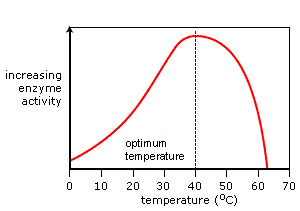
pH affects enzyme activity
Work best at optimum pH, if pH moves away (lower or higher) from the optimum, RoR slows down.
Change in pH above and below optimum breaks bonds holding enzymes together.
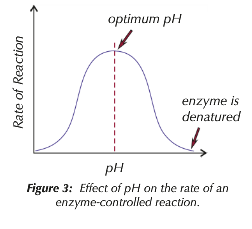
Practical: how enzyme activity (amylase) is affected by change in temp.
Add 5cm³ starch solution to test tube + heat to set temp. using water beaker with Bunsen burner
Add a drop of iodine to each of the wells of a spotting tile
Use syringe to add 2cm³ of amylase to starch solution + mix well
Every min, transfer a droplet of solution to a new well of iodine solution (should turn blue-black)
Repeat transfer process until iodine solution stops turning blue-black (meaning amylase has broken down all starch)
Record time taken for reaction to be completed
Repeat investigation for a range of temps (from 20ᵒC to 60ᵒC)
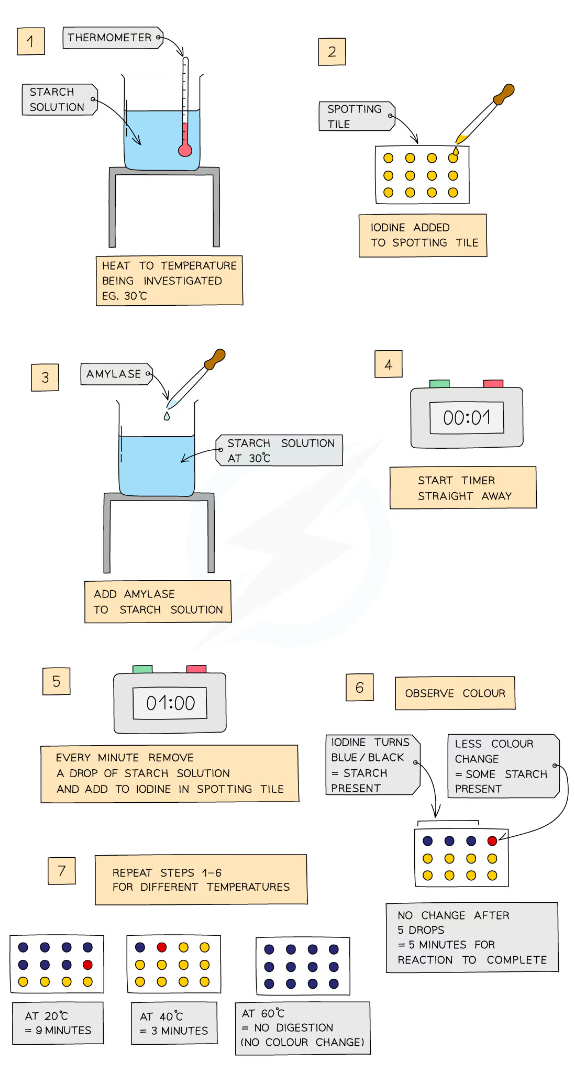
Results: how enzyme activity (amylase) is affected by change in temp.
Amylase is enzyme which breaks down starch
Quicker the reaction is completed, faster the enzyme is working
This investigation shows:
At optimum temp., iodine stopped turning blue-black the fastest
Because enzyme is working at fastest rate and has digested all starch
At colder temps (below optimum), iodine took longer time to stop turning blue-black
Because amylase enzyme is working slowly due to low kinetic energy and few collisions between amylase + starch
At hotter temps (above optimum) the iodine turned blue-black throughout whole investigation
Because amylase enzyme has become denatured so can no longer bind with starch or break it down
Limitations:
Method described to control temp isn’t very precise → better to use water baths
Starch and amylase solutions to be used should be placed in water bath and allowed to reach temp (using thermometer) before being used
Diffusion
Net movement of particles from area of higher conc. to lower conc.
Osmosis
Net movement of water molecules across partially permeable membrane from region of higher water conc. to lower water conc.
Active transport
Movement of particles against a conc. gradient (i.e. from area of lower conc. to higher conc.) using energy released during respiration
Factors that affect diffusion
SA:Vol ratio
Distance
Temp
Conc. gradient
How SA:Vol ratio affects diffusion
Larger SA:Vol ratio = faster diffusion
Smaller cube has larger SA:Vol ratio - meaning substances move into and out of this cube faster
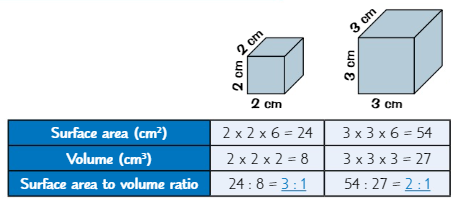
How distance affects diffusion
Shorter distance = faster diffusion because less time taken to travel
How temp affects diffusion
Higher temp = faster diffusion
As particles get warmer, they have more energy so move faster
How conc. gradient affects diffusion
Higher conc. gradient (bigger difference between inside and outside of cell) = faster diffusion
If there are lots more particles on one side, there are more to move across
How to investigate diffusion in non-living system
Make up some agar jelly with phenolphthalein (pink in alkaline and colourless in acidic) and dilute sodium hydroxide (makes jelly pink)
Put some dilute hydrochloric acid in beaker
Cut out a few cubes from jelly and put them in beaker of acid
If you leave cubes for a while, they eventually turn colourless as acid diffuses into agar jelly + neutralises sodium hydroxide
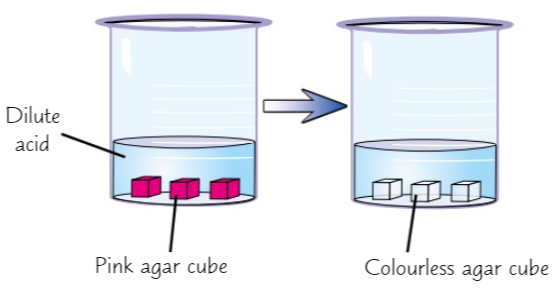
Practical: investigating diffusion in living system
Potato cylinders
Cut up potato into identical cylinders
Get beakers with diff sugar solutions in them - one should be pure water, another should be very concentrated sugar solution, and a few with concentrations in between
Measure length of cylinders, then leave a few cylinders in each beaker for half an hour
Take them out and measure lengths again
If cylinders have drawn water by osmosis, they’ll be longer
If water has been drawn out, they’ll have shrunk
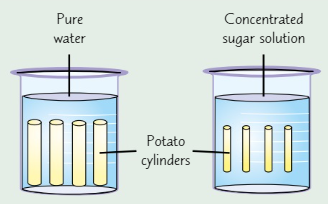
Practical: investigating diffusion in non-living system
Visking tubing
Fix some Visking tubing over the end of a thistle funnel, then pour some sugar solution down glass tube into thistle funnel
Put thistle funnel into beaker of pure water - measure where sugar solution comes up to on the glass tube
Leave apparatus overnight, then measure where solution is in glass tube
Water should be drawn through Visking tubing by osmosis, forcing the solution up the glass tube
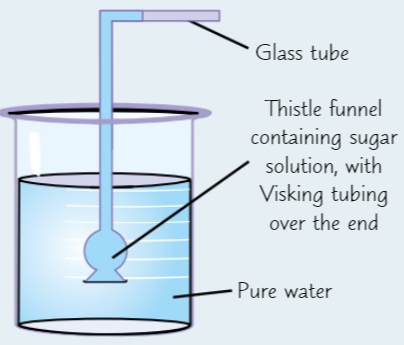
Photosynthesis
Plants make own food using PSN, converting light energy into chemical energy
Photosynthesis equation
Carbon dioxide + Water --sunlight→ Glucose + Oxygen
6CO₂ + 6H₂O → C₆H₁₂O₆ + 6O₂
How CO₂ conc. affects rate of PSN
One of the raw materials needed for PSN
Increase CO₂ conc. = increased rate of PSN up to a point, then graph flattens out, as CO₂ is no longer limiting factor
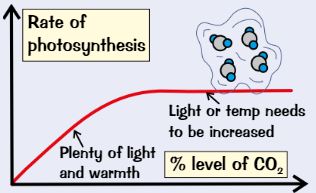
How light intensity affects rate of PSN
Chlorophyll uses light energy to perform PSN, it can only do it as quickly as light arrives
Increase light intensity = rate of PSN increases steadily up to a certain point
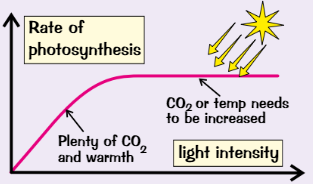
How temp. affects rate of PSN
Affects PSN rate because affects enzymes involved
Temp increases = PSN rate increases up to a point
Temp too high (over ~45ᵒC) = plant’s enzymes denatured, so PSN rate rapidly decreases
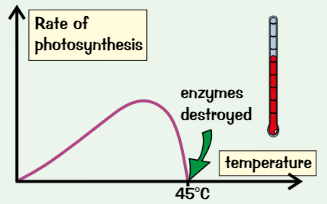
Leaf adaptations for photosynthesis
Broad leaves = large SA exposed to light
Palisade layer has most chloroplasts, near top to get most light
Upper epidermis = transparent, light can pass through to palisade layer
Have network of vascular bundles (transport vessels, xylem + phloem), deliver water + other nutrients to every part of leaf + take away glucose produced by PSN; also help support leaf structure
Waxy cuticle helps reduce water loss by evaporation
Leaf adaptations for efficient gas exchange also make PSN more efficient
e.g. lower surface full of stomata: little holes which let CO₂ diffuse directly into leaf
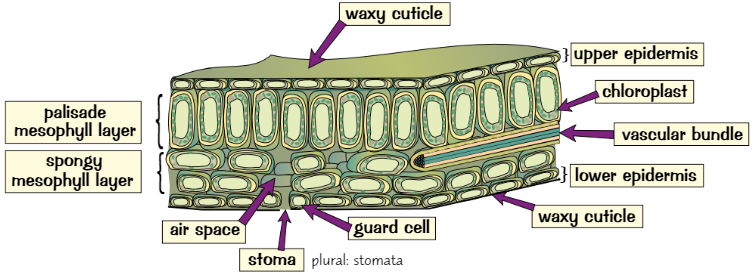
Mineral ions in plants
Needed for growth in plants
Magnesium - to make chlorophyll (to photosynthesise)
deficiency → yellow leaves
Nitrates - to make amino acids, for cell growth
deficiency → stunted, older leaves turn yellow
Phosphates - to make DNA + cell membranes, for respiration + growth
deficiency → poor root growth, older leaves turn purple
Potassium - helps enzymes needed for PSN and respiration
deficiency → poor fruit + flower growth, discoloured leaves
Photosynthesis investigation (starch production)
Get some Elodea pondweed
Add some NaHCO₃ solution to give an excess of CO₂
Place in a temp. controlled water bath at 30ᵒC
Put an upturned measuring cylinder, full of solution of the pondweed
From a distance of 100cm shine a 40W bulb on the Elodea and eliminate all other light sources
Count the number of bubbles produced in 5 minutes
Repeat at 100cm another three times
Reduce the distance by 10cm each time from 100cm-10cm and carry out again, three times
Photosynthesis investigation (need for chlorophyll)
Drop leaf in boiling water to kill cells and break down cell membranes
Leave leaf in a hot ethanol boiling tube for 5-10 mins (removes chlorophyll so colour changes from iodine can be seen more clearly)
Dip leaf in boiling water to soften
Spread leaf on white tile and cover with iodine solution
Green leaf - entire leaf will turn blue-black as PSN is occurring in all areas of leaf
Can use a variegated leaf (part green, part white) to test need for chlorophyll
White areas of leaf contain no chlorophyll - only areas containing chlorophyll stain blue-black
Areas with no chlorophyll remain orange-brown as no PSN is occurring so no starch is stored
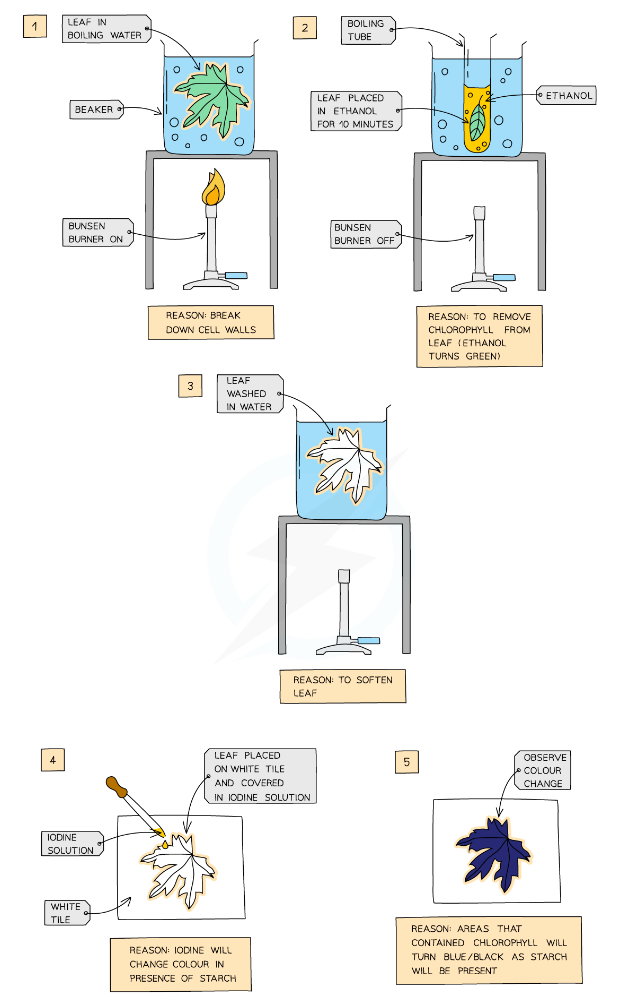
Photosynthesis investigation (need for light)
Same procedure as previous can be used to test need for light
Before starting, plant must be destarched by placing in dark cupboard for 24hrs to ensure any starch that is already present in the leaves will be used up and not affect results
After destarching, partially cover a leaf with aluminium foil and place plant in sunlight for a day
Leaf can be removed and tested for starch using iodine
Area of leaf covered in foil remains orange-brown (no sunlight so no PSN) and area exposed to sunlight will turn blue-black
Photosynthesis investigation (need for CO₂)
Destarch two plants by placing in dark for 24hrs
Put one plant in bell jar containing a beaker of sodium hydroxide (absorb CO₂ from air)
Place other plant in bell jar containing beaker of water (control experiment), which won’t absorb CO₂ from air
Place both plants in bright light for several hours
Test both plants for starch using iodine
Leaf from plant placed near sodium hydroxide remains orange-brown (no PSN due to lack of CO₂)
Leaf from plant placed near water turns blue-black (had all requirements for PSN)
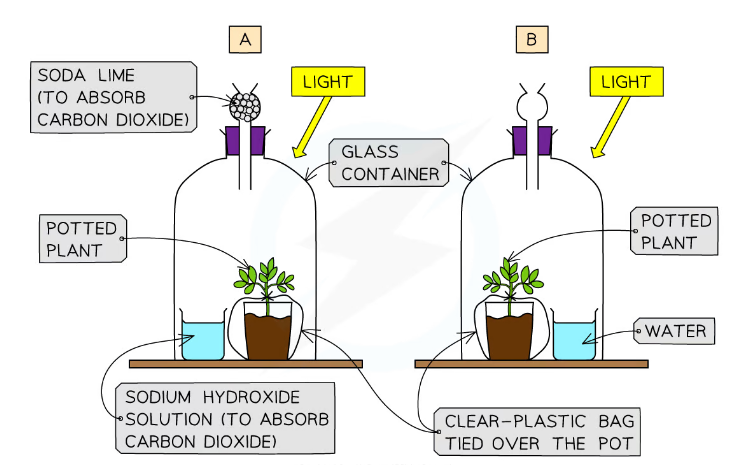
Photosynthesis investigation (evolution of O₂)
Take a bundle of shoots of a water plant (e.g. Elodea)
Submerge them in water beaker underneath upturned funnel
Fill boiling tube with water and place it over end of funnel
As O₂ is produced, bubbles of gas will collect in boiling tube and displace water
Show that the gas collected is O₂ by relighting glowing splint
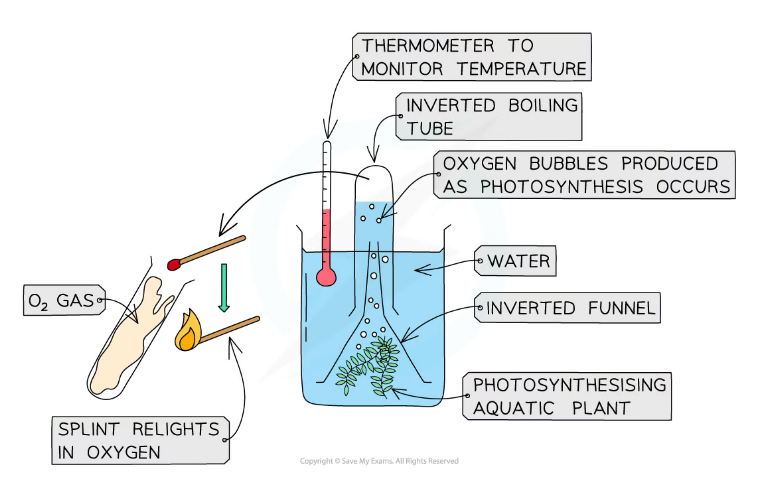
Balanced diet
Carbohydrates
Protein
Lipids
Vitamins and minerals
Water
Fibre
Water
Helps break down food to absorb nutrients
Fibre
Helps waste move smoothly through the gut
Found in wholemeal bread, fruit
Vitamin A
Helps improve vision, keeps skin + hair healthy
Found in liver
Deficiency can cause night-blindness, eye ulcers
Vitamin C
Forms part of collagen protein, makes up skin, hair, bones
Found in citrus fruit e.g. oranges
Deficiency can cause scurvy (liver spots on skin, bleeding gums)
Vitamin D
Needed for calcium absorption
Found in eggs
Deficiency can cause rickets (softening of child's bones leading to fractures/deformity)
Calcium
Needed to make bones + teeth
Found in milk, cheese
Deficiency can cause osteoporosis
Iron
Needed to make haemoglobin to carry O₂
Found in red meat
Deficiency can cause anaemia (tiredness, shortness of breath, paleness due to less O2 reaching cells so less respiration/energy)
Why energy requirements can vary
Activity level: more active people need more energy than sedentary people (e.g. office worker needs 10,000kJ a day, manual worker needs 15,000kJ a day)
Age: children + teens need more energy than older people - need energy to grow + generally more active
Pregnancy: greater mass = more energy needed + energy for baby to develop
Investigating energy content of food sample
Need dry food that burns easily
Weigh a small amount of food, skewer it on mounted needle
Add a set volume of water in a test tube (held with clamp)
will be used to measure amount of energy released when food is burnt
Measure water temp, then set fire to food using Bunsen flame
Hold burning food under boiling tube until it goes out
Relight food + hold under tube - keep doing until food doesn’t catch fire again
Measure temp of water again
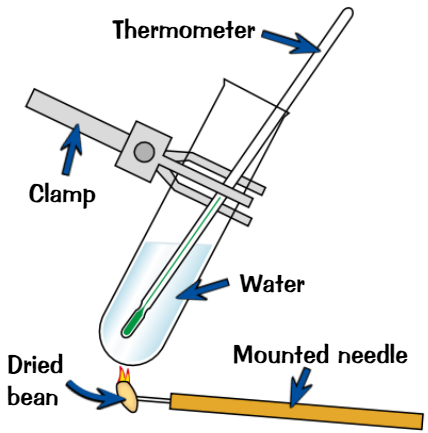
Energy equation
J per g = (temp rise x water mass) x 4.18 / mass of food (g)
Digestive system diagram

alimentary canal
the whole passage along which food passes through the body from mouth to anus. includes oesophagus, stomach, and intestines.
Mouth
Salivary glands produce amylase enzyme in saliva
Teeth mechanically break down food
Oesophagus
Muscular tube connecting mouth to stomach
Stomach
Mechanically digests food by churning actions
Produces protease enzyme, pepsin
Produces HCl to:
Kill bacteria
Give optimum pH for protease enzyme to work (pH 2 - acidic)
Liver
Produces bile
Gall bladder
Stores bile
Pancreas
Produces protease, amylase, lipase enzymes + releases them into small intestine
Small intestine
Absorbs nutrients out of alimentary canal into body
Produces protease, amylase, lipase enzymes to complete digestion
First part: duodenum, last part: ileum
Large intestine
Absorbs excess water, salts and Vitamin K
Rectum
stores faeces to be released via anus
Bile
Produced in liver, stored in gallbladder
Bile released from gallbladder and reaches small intestine via bile duct
Functions:
alkaline so neutralises stomach acid to provide optimum pH for enzymes in small intestine to work
emulsifies fats (breaks them up into small droplets → larger SA for enzyme lipase to work on = faster digestion)
Peristalsis
Series of wave-like muscle contractions to push food down the gut (oesophagus + small intestine)
Protease
proteins → amino acids
produced in stomach (pepsin), pancreas (released into small intestine), small intestine
optimum pH - 2 in stomach, 7-8 in small intestine
Carbohydrase
Carbohydrates ➡ glucose
e.g. amylase + maltase
Lipase
lipids ➡ glycerol + fatty acids
produced in pancreas, small intestine
optimum pH - 8 in small intestine and pancreas
Small intestine adaptations
Ileum (small intestine) is very long to provide large surface area for absorption of digested food
Finger-like projections called villi (each have microvilli) to increase SA for digested food to diffuse across, giving a faster rate of diffusion
Villi have thin walls (one cell thick) for short diffusion distance so digested food can rapidly pass through wall
Has good blood supply, each villus with its own capillary so digested food can be rapidly absorbed + carried away by blood so diffusion gradient is maintained for efficient diffusion
each villus has a lacteal where digested fats are absorbed
Respiration
Process of transferring energy from glucose - happens constantly in every living cell
Produces ATP which stores energy needed for many cell processes
When a cell needs energy, ATP molecules are broken down + energy is released
Aerobic respiration
Needs oxygen
Most efficient way to transfer energy from glucose
Most common type of respiration used
glucose + oxygen → carbon dioxide + water (+ energy)
C₆H₁₂O₆ + 6O₂ → 6CO₂ + 6H₂O
Anaerobic respiration
When you do intense exercise, body can’t supply enough O₂ to muscles for aerobic respiration so needs anaerobic respiration
Releases less energy per glucose molecule than aerobic respiration
Glucose only partially broken down → lactic acid also produced
Lactic acid builds up in muscles, gets painful and leads to cramp
glucose → lactic acid (+ energy)
Anaerobic respiration in plants
Produce ethanol + CO₂ instead of lactic acid
glucose → ethanol + carbon dioxide (+ energy)
Investigating CO₂ produced by respiring seeds
Can use hydrogen-carbonate indictor to show living organisms produce CO₂ as they respire
Solution is orange but changes to yellow in presence of CO₂
Soak some dried beans in water for 1 day
They will start to germinate. Germinating beans respire.Boil a similar-sized, second bunch of dried beans. This will kill the beans + make sure they can’t respire. Dead beans act as your control.
Put same amount of hydrogen-carbonate indicator in 2 test tubes
Place gauze platform in each test tube and place beans on it
Seal test tubes with rubber bung
Leave apparatus for set period of time (e.g. 1hr)
During that time, CO₂ should have turned the hydrogen-carbonate indicator yellow
